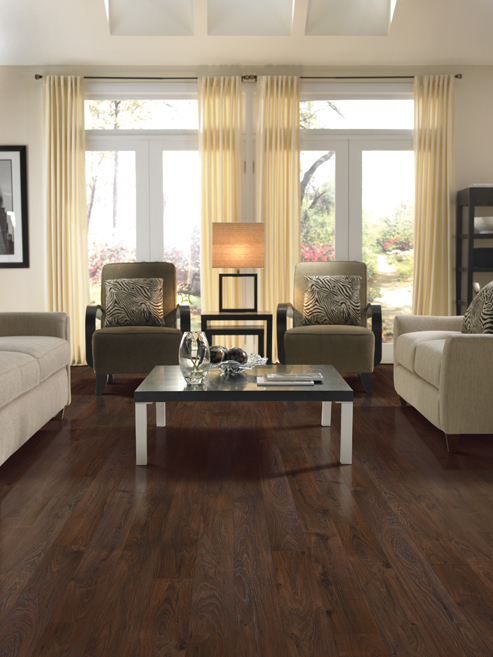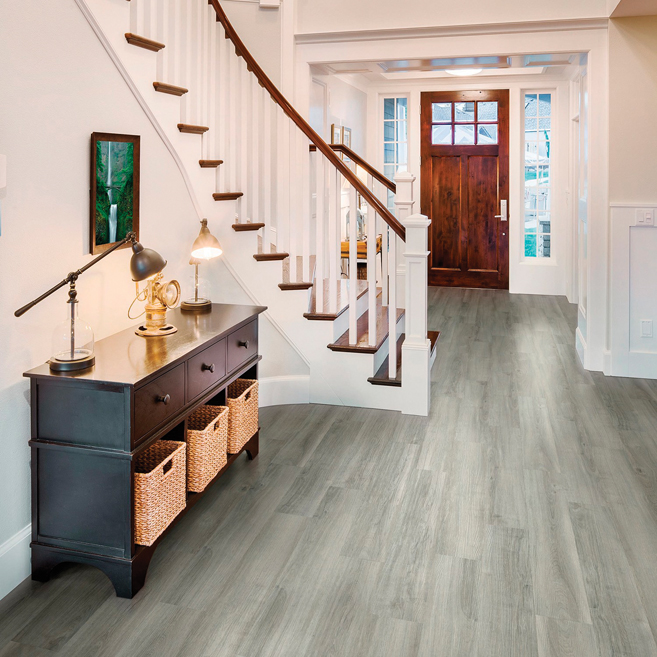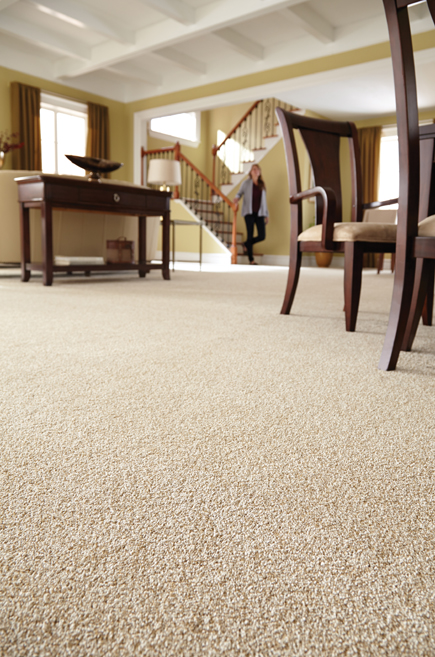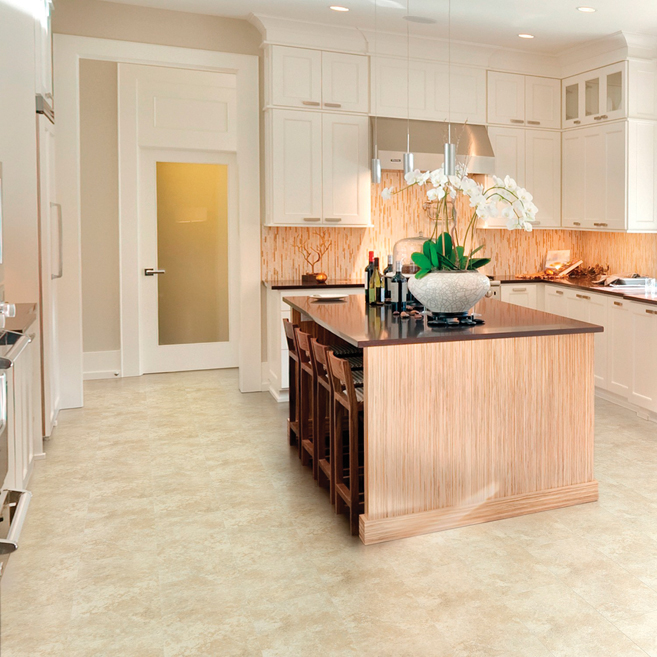 If you haven’t shopped for flooring recently and you’re considering a fresh look underfoot for your Smith Mountain Lake home, you’ll surely have a spring in your step knowing you’ve got more choices than ever before. The industry has blossomed so much in recent years that carpet and wood no longer rule the roost. Here, we present some lake-friendly options and shopping tips to help you undertake your flooring project with confidence.
If you haven’t shopped for flooring recently and you’re considering a fresh look underfoot for your Smith Mountain Lake home, you’ll surely have a spring in your step knowing you’ve got more choices than ever before. The industry has blossomed so much in recent years that carpet and wood no longer rule the roost. Here, we present some lake-friendly options and shopping tips to help you undertake your flooring project with confidence.
High Style, High Performance
“Companies have become much more innovative with colors and designs in the flooring industry in the past three years,” says Joe Russell, floor covering specialist at Interiors by Kris in Westlake. Now you can get just the look you want without sacrificing the performance your lifestyle dictates, whether you prefer the softness and endless color and style options of carpet, traditional hardwood flooring, or want to explore the latest innovations in other types of highly durable flooring.
One option growing exponentially in popularity with SML homeowners, Russell says, is luxury vinyl tile (LVT), now available from most flooring manufacturers. “They’ve come out with some awesome looks in simulated wood and stone, which gives a lot of design flexibility,” he says. LVT comes in traditional square tiles as well as wood-look planks in varying sizes, which gives it the flexibility to suit a variety of tastes and flooring situations—including the ability to be installed on surfaces and locations that may not be naturally well-suited to traditional flooring installations. It also meets the tough demands of lake living, where dripping bathing suits, wet dogs, and red clay-encrusted flip flops can wreak havoc on carpet or traditional wood in lake-access levels or in often-wet bathrooms. “They’re using larger and larger planks now, which allows LVT to be glued down or floated, and that adds a lot of installation versatility. It’s also very durable and easy-maintenance. LVT is taking over in places where traditional flooring hasn’t been as maintenance-friendly,” he says.
 LVT is also budget-friendly compared to its traditional wood and tile counterparts. “It’s definitely more affordable than real wood or real tile, and the labor is much more affordable because it goes down so easily,” Russell says. “It’s easy to maintain—you don’t have to re-polish it like you do the old vinyl composition tile. The wood look has grains that are very prominent, as are the knots, so it looks just like real wood.”
LVT is also budget-friendly compared to its traditional wood and tile counterparts. “It’s definitely more affordable than real wood or real tile, and the labor is much more affordable because it goes down so easily,” Russell says. “It’s easy to maintain—you don’t have to re-polish it like you do the old vinyl composition tile. The wood look has grains that are very prominent, as are the knots, so it looks just like real wood.”
Additionally, LVT is comprised of a vinyl top layer, a waterproof core, and a cork backing, which makes it a completely waterproof surface that is softer underfoot (thanks to the cork layer) and is less slippery than ceramic or porcelain tile—a bonus when considering covering an area of your home that may see frequent lake traffic.
New Options for Old Standbys
The carpet industry also has seen some new innovations, in both areas of style and durability, which is great news for those who still love its coziness in their bedrooms, for example. One new feature borrows from the commercial carpet sector. “There are some really cool ideas some carpet industry leaders have come out with in carpet squares,” says Cindy Hall, an interior designer and flooring expert at Capps Home Building Center in Moneta. “You can actually make an area rug by combining a couple of different patterns and creating a really inexpensive, cool look for an area rug underneath a dining table, or under a bed, within a larger area of carpet.” Hall says carpet squares also deserve consideration for their ease of replacement. “Say you had someone spill something in one area of your carpet. That carpet square can be popped up, a new square put down, and you don’t have that stain any longer. Squares are where I see the trend going with carpet.”
 Another key development in carpet from top brands is an entirely waterproof backing on wall-to-wall carpet, which can prevent wicking problems with stains that would otherwise absorb down to the pad, then “wick” up and reappear from deep down after initially appearing to lift from the surface of the carpet with professional cleaning.
Another key development in carpet from top brands is an entirely waterproof backing on wall-to-wall carpet, which can prevent wicking problems with stains that would otherwise absorb down to the pad, then “wick” up and reappear from deep down after initially appearing to lift from the surface of the carpet with professional cleaning.
Traditional hardwood hasn’t lost its appeal, either. “Wood will always hold value in the house,” says Bob Garby, flooring specialist at Whitt Carpet One Floor and Home in Salem. “From a real estate standpoint, there are a lot of homes on the lake that have natural hardwood in them.” Often called three-quarter-inch hardwood, this flooring has seen advancements that include an aluminum-oxidized polyurethane coating, which is stronger and makes the wood more scratch resistant than traditional polyurethane coating. Many manufacturers also now offer hand-scraped and brushed finishes that give an already-aged look, so that when scratching does occur, it adds to the patina of the wood and makes a scratch less visible than in wood flooring of the past. Placement of wood in a lake home, however, needs to be carefully considered, says Garby. “Typically we don’t recommend using wood in a lower level that walks in from the lake or even from an outside grassy area,” he notes. Since wood expands and contracts with the seasons and also does not co-exist well with water, Garby recommends keeping it in areas of your home that do not see heavy lake traffic or lots of pet activity.
No matter what your taste, lifestyle and budget dictates, you can now bring new floors to your home that are more in-tune with you than ever before. Do some research, ask a lot of questions and seek out a flooring provider who’s willing to help you see the project through, then enjoy living easier (and more beautifully) on the lake with care-free flooring underfoot.
Score Your Floor
 Successfully completing a flooring project in your home that’s on point from a style, durability and budget perspective is perhaps both more exciting and challenging than ever, given all the new options available. Here are some tips to help you shop like a pro.
Successfully completing a flooring project in your home that’s on point from a style, durability and budget perspective is perhaps both more exciting and challenging than ever, given all the new options available. Here are some tips to help you shop like a pro.
- Carefully consider your use of the floor. Think about traffic patterns, including pet traffic, ages of your family and guests now and into the future, and how a room’s purpose may change in five or ten years. Also consider proximity to water and outdoor environments.
- Do your own research and ask the showroom for their newest products. Cindy Hall with Capps Home Building Center advises you to carefully research the particular flooring product that has piqued your interest so that you’re aware of all the options in that category. New products hit the market frequently.
- Pay close attention to the warranty offered on the floor and register for that warranty with the manufacturer immediately to activate it.
- Consider having the retailer measure your home BEFORE you shop. Bob Garby of Whitt Carpet One Floor and Home says having your home measured before you shop can give you a better idea of labor and prep costs on different flooring choices, and can reveal any areas that might only be able to be covered with carpet because of unevenness or structural considerations.
- Build a relationship. Work with the same salesperson and installation team through the entire process so that as you go from measuring to selection to installation, you don’t have to continually explain yourself to new people who have never seen your house or heard your flooring history, concerns and preferences.
